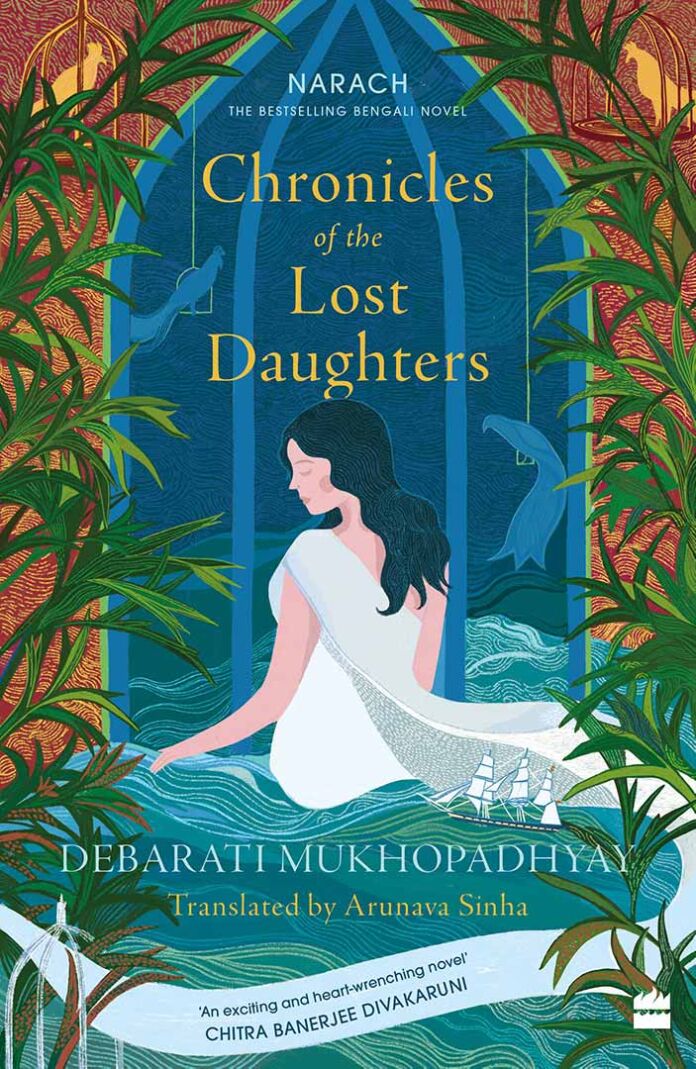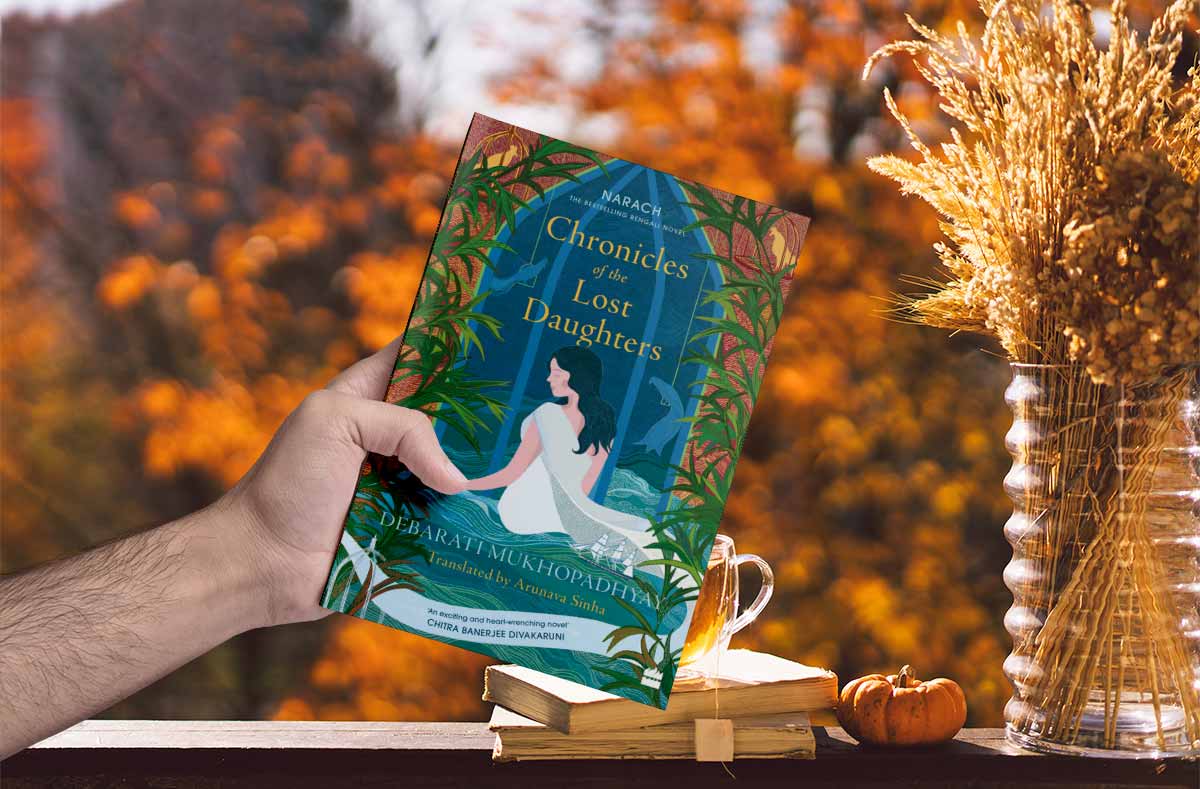Title: Chronicles of the Lost Daughters
Author: Debarati Mukhopadhyay
Publisher: Harper India
Genre: Historical Fiction
First Publication: 2022
Language: English
Book Summary: Chronicles of the Lost Daughters by Debarati Mukhopadhyay
When unspeakable tragedy befalls Bhubonmoni, a young widow, she must leave her village along with her brother, Krishnoshundor, and his family. Ensnared by the wily entrepreneur Nobokishore Dutta, they end up in an overcrowded depot near a port, soon to be packed into a ship sailing to Surinam, where they will be sold as sugarcane plantation slaves.
But Fate has other plans. Bhubonmoni finds herself being led away from the port and her family to be stowed away in a secret location in Calcutta. Not too far away, a young rebel Shourendro is swept up by the ideas of the Brahmo Samaj.
Meanwhile in Metiabruz, a shy musician Chondronath impresses the exiled Nawab of Lucknow with his art. None of them know it yet, but the stars are aligning despite overwhelming odds for them to meet under curious circumstances…
Set against the vibrant background of late nineteenth-century Bengal, Debarati Mukhopadhyay’s beautifully woven novel brings together the glory and the decadence of colonial times. Fast-paced and thrilling, with a lively cast of characters including historical figures such as Nawab Wajid Ali Shah, Rabindranath Tagore, and Dr Kadambini Ganguly, Chronicles of the Lost Daughters is an unforgettable saga.
Book Review: Chronicles of the Lost Daughters by Debarati Mukhopadhyay
Chronicles of the Lost Daughters, which was originally written in Bengali as “Narach” and has since become a best-selling book, vividly depicts the magnificence and depravity of Bengal during the late nineteenth century under British colonial rule. In the narrative of this novel, many historical figures, including Nawab Wajid Ali Shah, Kadombini Gangopadhyay, and Rabindranath Tagore, make appearances. The plot opens in the year 1885 in Calcutta with Bhubonmoni, a young woman who recently lost her husband. Bhubonmoni decides to leave the village with her brother Krishnoshundor and his family after she is sexually assaulted by two men and becomes a target for other predators in the village. The story follows Bhubonmoni’s journey to a new life in the city of Calcutta.
Bhubonmoni’s brother, Krishnoshundor Chattopadhyay, is a knowledgeable yet modest and somewhat naïve brahmin who trusts in the principles of the vedas. Unfortunately, when his sister is raped, he and his family, including his sister Bhubonmoni, are compelled to flee the village and find themselves in the hands of Nobokishore Datta, a wealthy, powerful, but crooked trader who would stop at nothing to get his hands on more money. During his visit to their village, Nobokishore approached Krishnosundar with a job opportunity that included a generous salary and made empty promises.
Soon, they find themselves at a depot close to a port, where they will eventually be crammed onto a ship bound for Surinam. Once they get to Surinam, they’re going to be sold as slave labour to work on sugarcane plantations there. Bhubonmoni is saved from the depot in the last moments before the ship sails by a relative who also happens to be the spouse of Kadombini Gangopadhyay, the first Indian female doctor. The two daughters of Krishnoshundor do not have such good luck.
The slave trader Nobokishore Dutta has three wives and two mistresses, but he hasn’t been able to father a son. A charlatan convinces him that marrying a 10-year-old high-caste girl is the only way out of his predicament. Because Nobokishore belongs to a low caste, he abducts both of Krishnoshundor’s little daughters. As a result, Krishnoshundor is forced to make the perilous journey across the ocean with just his wife and their young boy.
The plot then shifts to Chondronath, a young musician in an entirely new neighbourhood of Calcutta. He has travelled all the way to Metiabruz in the pursuit of creating his fortune in this affluent and pleasure-oriented region. The Metiabruz was founded by Nawab Wajid Ali Shah, who had been forced to flee Lucknow because of the British. During this time, Chondronath develops feelings for Moti, a gorgeous singer. Despite the fact that Moti is the Nawab’s daughter by one of his mistresses, she is not provided for financial help and is forced to engage in prostitution in order to make ends meet. Chondronath has made it his mission to rescue her, despite the fact that she is the mistress of Nobokishore.
Finally, we see Bhubonmoni thrive in the compassionate home of the Gangopadhyays. Their residence serves as a safe haven for thinkers, social justice warriors, and activists, such as Shourendro, a politically active student. The principles of the Brahmo Samaj have a strong influence on the youthful revolutionary Shourendro. We follow their incredible journeys over a long period as each of them struggles for a life of their own, radically affecting each other’s destiny and establishing a complicated connection defined by regret, rebellion, and estrangement.
As the narratives build up to an exciting climax, a few of the characters will suffer loss and sadness, and it is through these trials that they will discover the strength to keep going and a deeper understanding of who they are. Debarati Mukhopadhyay, writing at the peak of her storytelling and creative powers, has crafted a masterpiece that explores themes of hope, courage, the struggle for liberty, and the need to have a voice in the world. Another recurring theme is the metaphorical wings that Bhubonmoni develops as she navigates the ups and downs of life and matures as a result of her encounters with adversity and grief. As she grows into the powerful lady, she was confronted with significant emotional challenges, including the death of her spouse and her dreams, as well as a terrible hatred from society.
The Chronicles of the Lost Daughters is a tale that is both well-written and really enjoyable to read. It has a large number of memorable characters and the atmospheric pull of page-turners, yet it does not compromise depth in favour of overdramatizing the terrifying events that befall upon the protagonists of the story. This is the kind of book that will keep you engaged from the outset and completely absorbed by the time you reach the final page.
The author did a wonderful job featuring powerful women who take the lead in the story and whose struggles for liberation, empowerment, and expression will leave readers feeling moved. This gorgeously written book is a feat of narrative that looks with unblinking eyes at a catastrophic wound in history. The excellent way this story was written commemorates this part of history in such a way that many new generations of readers will get to learn about it.






